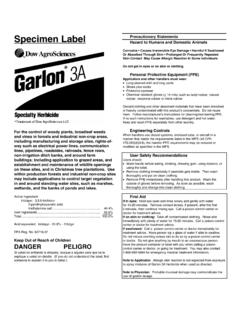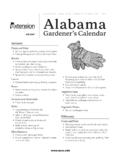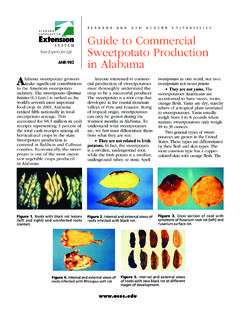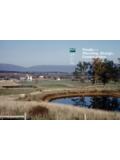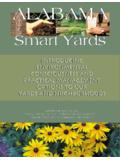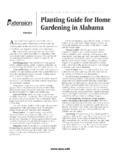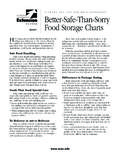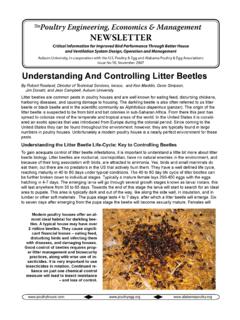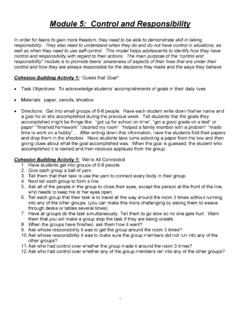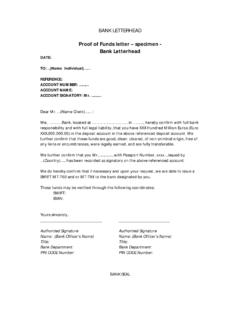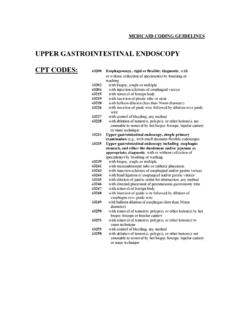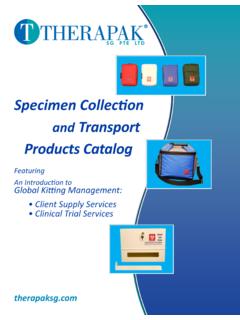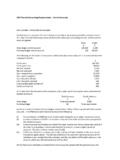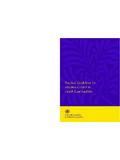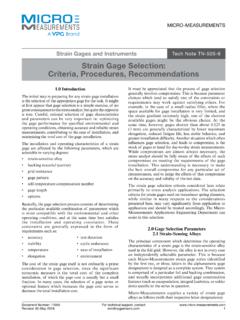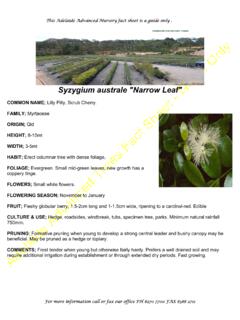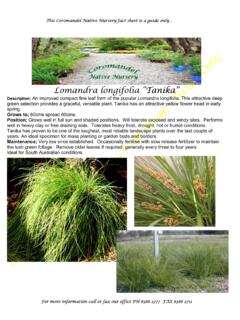Transcription of A Key to Common Native Trees of Alabama - aces.edu
1 A Key to Common Native Trees of Alabama ANR-0509 Alabama A&M AND AUBURN oakSilver MapleMockernut Hickoryloblolly pinecucuMbertreeSHortleaf pinecoMMon perSiMMonbitternut HickoryWinged elMWater oakSHagbarkHickoryvirginia pineeaStern cottonWoodblackjack oak2 eaStern redbudcHeStnut oakblack WalnuteaStern redcedarSoutHern red oakaMerican beecHSHuMard oakaMerican Hollylongleaf pineaMerican elMovercup oakyelloW-poplar or tuliptreered MapleA Key to Common Native Trees of AlabamaThis key can help you identify 69 of the most Common Native Trees found in Alabama . Keys such as this one, which is based on a series of choices be-tween two statements, are called dichotomous keys. This key was designed for use during the growing season; therefore, leaf characteristics are the primary features used for listing of the Common and scientific names for the 69 Trees is found on page 9. This key will not work for Trees that do not appear on this list. The following suggestions should help you as you begin working with the key:(1) Always start at the beginning of the key and follow it step by step.
2 Each choice will refer you to the next step, which may be a number, another section in the key, or the conclusion or species. It is a good practice to write down your order of progress, such as 1 - 2 - 4. This will make it easier for you to find and correct mistakes.(2) Always read both choices, even if the first choice sounds correct. The second one may sound even better.(3) If the choice between two statements is not clear, or you don t have enough information to make the choice, follow both choices to their con-clusions. Then, try to choose between the descriptions of the two resulting answers.(4) Always look at several samples when keying a specimen. Key charac-teristics, especially leaves, can vary even on the same tree.(5) When measurements are given, as in the size of the leaves, don t guess. Use a ruler.(6) Become familiar with the botanical terms used to describe Trees . Terms used in this key are illustrated on pages 10 through of the species covered do not occur throughout the state.
3 The fol-lowing codes indicate the general range where each occurs. S southern third of state, C central portion of state, N northern third of state, A all of MulberrySycaMoreSlaSH pineWHite oakriver bircHSWeet bayA Key to Common Native Trees of Alabama 34 Alabama Cooperative Extension SystemTree Identification Key1. Leaves needle-like or scale-like; Trees with cones .. see Conifers1. Leaves flat and broad; Trees without cones .. see HardwoodsConifers1. Leaves needle-like .. 21. Leaves scale-like, sometimes longer ( inch) pointed on the end and prickly to the touch; bark reddish-brown and fibrous; cones look like bluish-gray berries about inch in diameter; cones occur only on female Trees .. (A) eastern redcedar2. Needles attached to the twig in bundles or clusters .. see Yellow Pines2. Needles flat, attached to the twig separately, not in bundles or clusters .. 33. Needles yellow-green, - to -inch long; foliage has a feather-like appearance and falls off in the winter; (in closely related pond cypress, needles are overlapping on branchlets that curve upwards); bark fibrous, scaly, reddish brown but weathers to ash-gray; cones rounded like a ball; Trees are found most commonly in swamps.
4 (SC) baldcypress3. Needles are shiny-green above with 2 white stripes underneath, / to inch long; cones light-brown, borne on the ends of the branches; Trees evergreen; drooping branches may hang to the ground .. (N) eastern hem lockYellow Pines1. Needles in bundles or clusters of 3 .. 21. Needles primarily in bundles or clusters of 2, or sometimes 2 and 3 on the same tree .. 32. Needles 5 to 9 inches long; cones 3 to 6 inches long and prickly to the touch .. (A) loblolly pine2. Needles 8 to 18 inches long; cones large in size, 6 to 10 inches long; seedlings look like clumps of grass .. (SC) longleaf pine3. Needles less than 5 inches long .. 43. Needles usually 7 to 12 inches long, usually 2, sometimes 3 needles per bundle; cones 2 to 6 inches long, glossy, and not prickly when squeezed .. (S) slash pine4. Needles t wisted .. 54. Needles straight, 3 to 5 inches long; cones 1 to 3 inches long, bark often has small blisters on it.
5 (A) shortleaf pine5. Needles stout, 1 to 3 inches long yellow-green; cones 1 to 2 inches long with long prickles on scales; usually a very limby tree, bark orange-brown, usually found on dry sites .. (NC) Virginia pine5. Needles slender, 2 to 4 inches long, dark green; cones 2 to 3 inches long; bark silver-gray, furrowed, more like the bark of a hardwood than a pine; Trees usually found in stream bottoms .. (SC) spr uce pineHardwoods1. Leaves and buds opposite .. 21. Leaves and buds alternate .. 72. Leaves compound .. 32. Leaves simple .. 53. Leaves pinnately compound or trifoliate (three leaflets) .. 43. Leaves palmately compound .. (A) buckeye4. Leaflet edges smooth (entire), not toothed .. see Ashes4. Leaflet edges toothed (serrate) .. see Maples5. Leaves not lobed .. 65. Leaves lobed .. see Maples6. Leaves hear t-shaped .. (SC) southern catalpa6. Leaves oval-shaped with a pointed tip .. (A) flowering dog wood7. Leaves compound .. 8 Hardwoods (cont.) 7.
6 Leaves simple .. 11 8. Leaflet edges smooth (entire), not toothed .. 9 8. Leaflet edges finely toothed (serrate) .. 10 9. Leaves once pinnately compound; twigs often armed with paired unbranched thorns at base of (NC) black locust 9. Leaves once and twice pinnately compound; twigs and bark typically armed with thorns, com monly 3 -branched .. (A) honeylocust 10. Leaves with 15 to 23 leaflets; fruit a yellow-green ball 1 to 2 inches in diameter; bark gray-brown to black .. (NC) black walnut 10. Leaves with 5 to 17 leaflets, usually 15 or less .. see Hickories 11. Leaf edges smooth (entire) .. 12 11. Leaf edges toothed (serrate), with large or small teeth .. 20 12. Leaves lobed .. 13 12. Leaves not lobed .. 15 13. Leaves all approximately the same shape .. 14 13. Leaves mitten-shaped, 3-lobed and unlobed on the same tree; bark dark reddish brown; leaves, t wigs, and roots smell like root beer .. (A) sassafras 14. Leaves commonly 4-lobed, tulip-shaped; bark light gray.
7 (A) yellow-poplar 14. Leaves not 4 -lobed, fr uit an acorn .. see Oaks 15. Leaves heart-shaped, 3 to 5 inches; flower small and pinkish-purple; fr uit a bean (legume), 2 to 3 inches long .. (A) eastern redbud 15. Leaves not hear t-shaped .. 16 16. Leaf edges armed with sharp spines; fruit a red berry; tree evergreen .. (A) American holly 16. Leaf edges not ar med with shar p spines ..17 17. Twigs with narrow lines circling them where each leaf is attached .. see Magnolias 17. Twigs without narrow lines circling them .. 18 18. Twigs with single bud at the ends .. 19 18. Twigs with cluster of buds at end of t wigs, fr uit an acorn .. see Oaks 19. Base of leaves rounded, lateral buds dark and triangular ( snake head ), leaf scar with one slit-like bundle scar; fruit an orange to reddish purple berry; bark looks like the back of an alligator .. (A) com mon persim mon 19. Base of leaves v-shaped to rounded, occasional large teeth on some leaves, lateral buds slender, red-brown to green-brown, leaf scar with three bundle scars; fruit a bluish-black drupe.
8 See Tupelos 20. Leaves not lobed .. 21 20. Leaves lobed .. 31 21. Leaf edges singly toothed (serrate or coarsely serrate) .. 22 21. Leaf edges doubly ser rate .. 28 22. Leaf edges coarsely serrate (with large blunt teeth) or very shallowly lobed .. 23 22. Leaf edges more finely serrate .. 24 23. Leaves triangular, 5 to 9 inches long, edges with large rounded teeth; leaf stem (petiole) 2 to 3 inches long and flattened near base .. (A) eastern cottonwood 23. Leaves oval, with large rounded teeth or very shallowly lobed .. see Oaks 24. Leaves somewhat triangular, egg-shaped or hear t-shaped .. 25 24. Leaves oval to football-shaped .. 26 25. Leaf edges irregularly serrate, bottom half of leaves may have smooth edges, leaves 2 to 4 inches long, 1 to 2 inches wide, leaf tips may be very long or short, leaf veins make distinct V-shape at base of leaf; bark smooth gray with cork y war ts .. (A) sugarberr y 25. Leaf edges serrate, leaves 3 to 5 inches long, 2 to 3 inches wide; base heart-shaped or flattened; fruit small round, on long stalks attached to leafy bract; bark grayish brown becoming deeply furrowed.
9 (A) basswood A Key to Common Native Trees of Alabama 56 Alabama Cooperative Extension SystemHardwoods (cont.) 26. Lateral veins of leaves not distinctly parallel to each other .. 27 26. Lateral veins of leaves distinctly parallel to each other, with each vein ending at a tooth; buds brown, up to 1 inch long and cigar-shaped late summer through winter; bark thin, smooth and gray; leaves turn tannish-brown in the fall and stay on tree all winter .. (A) A merican beech 27. Leaf edges finely serrate, leaves 2 to 6 inches long, leaf stem (petiole) often with 1 or 2 small glands near leaf base; often with tawny hair along underside of midrib .. (A) black cherr y 27. Leaf edges with very fine teeth or bristly hairs, leaves 4 to 7 inches long, turn red in the fall; small white, urn-shaped flowers in showy sprays at ends of branches mid-summer; bark deeply grooved to blocky; trunk often leaning .. (A) sourwood 28. Leaves triangular to diamond shaped; bark pinkish to gray-brown, with peeling, papery layers exposing pinkish inner bark on young Trees and upper tr unk.
10 (A) river birch 28. Leaves oval to football-shaped .. 29 29. Leaf base round to hear t-shaped .. 30 29. Leaf base uneven, some twigs may have corky ridges or wings .. see Elms 30. Bark bluish gray, thin and smooth with a muscular appearance; buds brown and white-striped .. (A) A merican hornbeam 30. Bark reddish brown with thin, loose scales, often with a shreddy appearance; buds green and brown-striped .. (A) eastern hophornbeam 31. Leaf edges finely to coarsely serrate .. 32 31. Leaf edges with large, irregular teeth; leaves large and fan-shaped; bark brown and flaky, peeling off to expose smooth greenish or white inner bark, giving bark a splotchy appearance .. (A) sycamore 32. Leaves star-shaped; twigs often have corky wings; fruit a spiny ball .. (A) sweetgum 32. Leaves variable in size, unlobed, mitten-shaped or with 3 or more lobes on the same tree, upper surface of leaf sandpapery, leaf stem (petiole) ex udes milk y sap when cut.
